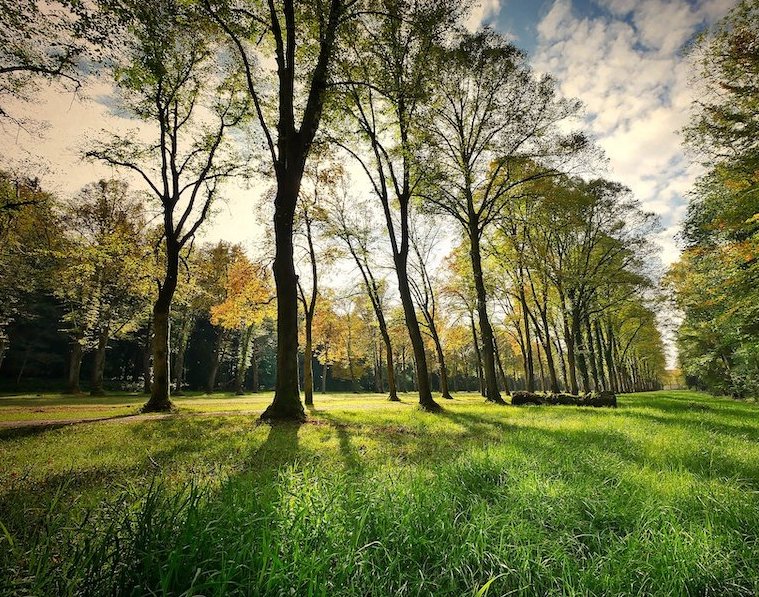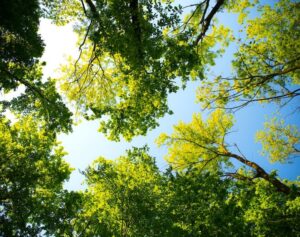Important Ways Trees Improve Our Lives

By Maegan Mullinax
If you conduct a quick Google search by typing in “why are trees important” or a similar phrase, the Internet will yield more than 200 million results, including lists of benefits, values, efforts to save trees, and more, in less than a second. Why? Because trees have such a great impact on our lives and ecosystem.
Trees provide far more than shade and curb appeal. The Arbor Day Foundation lists several ways these vital living organisms bring added value to our lives, the planet, wildlife, and beyond.
Trees help clean our air. Trees remove pollution from the atmosphere, improve air quality and improve human health. According to the U.S. Forest Service, in the greater Kansas City area alone, trees remove 26,000 tons of air pollution each year.
Trees contribute to our health. According to Harvard Medical School, spending time in nature can help reduce stress, anxiety, and depression, and maybe even improve our memory. We are fortunate in the green industry to work outdoors with trees daily, unlike other industries where professionals, such as office or health care workers, are not as fortunate.
Trees provide us with oxygen. A single large tree can provide one day’s supply of oxygen for up to four people, according to North Carolina State University.
Trees help clean our drinking water. The U.S. Forest Service shares that forested watersheds provide drinking water to more than 180 million Americans – that’s just over half of the population of the United States.
Trees provide much-needed cooling. Sit back, relax, and skip the sunburn. Thanks to trees, shaded surfaces may be 20 to 45 degrees (Fahrenheit) cooler than the peak temperatures of un-shaded materials, according to the United States Environmental Protection Agency. Want to plant a shady, fast-growing tree? Consider a weeping willow, Texas red oak, northern catalpa, red maple, or American sycamore.
Trees help reduce the effects of climate change. Trees are magical living creatures that have the power to absorb carbon dioxide (CO2), and remove and store carbon while releasing oxygen back into the air. In just one year, one acre of mature trees takes in the amount of CO2 produced by a vehicle driven 26,000 miles – that’s a little more than one trip around the Earth.
Trees help us save energy. Saving energy often leads to saving money, right? As it turns out, the United States Department of Energy agrees, and notes that if trees are positioned properly, they can reduce a household’s energy consumption for heating and cooling by up to 25%. This reduction could save an average U.S. household between $100 and $250 in energy costs annually.
Trees benefit wildlife. Trees provide vital wildlife habitats – including various pollinators that we work vigorously to protect.
Trees help reduce crime. Believe it or not, the University of Washington reports that when it comes to minor crimes, communities experience “less graffiti, vandalism, and littering in outdoor spaces with trees as a part of the natural landscape than in comparable plant-less spaces.”
Trees are a good investment of our public dollars. The U.S. Forest Service reports that investing in trees with regular maintenance is money well spent. Every dollar spent on planting and caring for a community tree yields benefits that are two to five times that investment – benefits that include cleaner air, lower energy costs, improved water quality, improved stormwater control, and increased property values.
Trees increase our property values. Research by Pacific Northwest Research Station showed that the presence of street trees increased sale prices of houses in Portland, Ore., neighborhoods by an average of $8,870 and reduced time on the market by an average of 1.7 days.
These examples demonstrate that it is imperative that we properly tend to and care for the trees around us, as life on Earth could not exist without trees. If you’re curious about the trees in your neck of the woods, consider using the Arbor Day Foundation’s Tree Identification Field Guide (https://www.arborday.org/trees/whatTree/) to identify a tree simply by the kinds of leaves it produces. And the next time you’re outdoors, take a moment to think about the ways trees better your life.
Maegan Mullinax is a business development manager and Safety Committee member at ACRT Services. She is an experienced arborist and horticulturalist and actively participates in the UVM industry. She is an ISA Certified Arborist, a member of the ISA Southern Chapter, and a member of the Fort Oglethorpe, Georgia Tree Board. She is also a member of the Georgia Tree Council and the Utility Arborist Association where she sits on the Professional Development Committee.
For more information, resources and articles, visit www.acrt.com.




